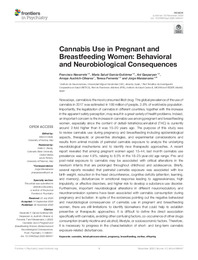Título :
Cannabis Use in Pregnant and Breastfeeding Women: Behavioral and Neurobiological Consequences |
Autor :
Navarrete Rueda, Francisco
García Gutiérrez, María Salud
Gasparyan, Ani
Austrich Olivares, Amaya
Femenía Cantó, Teresa
Manzanares, Jorge |
Editor :
Frontiers Media S.A. |
Departamento:
Instituto de Neurociencias
Departamentos de la UMH::Farmacología, Pediatría y Química Orgánica |
Fecha de publicación:
2020 |
URI :
https://hdl.handle.net/11000/35355 |
Resumen :
Nowadays, cannabis is themost consumed illicit drug. The global prevalence of the use of
cannabis in 2017 was estimated in 188 million of people, 3.8% of worldwide population.
Importantly, the legalization of cannabis in different countries, together with the increase
in the apparent safety perception,may result in a great variety of health problems. Indeed,
an important concern is the increase in cannabis use among pregnant and breastfeeding
women, especially since the content of delta9-tetrahidrocannabinol (THC) is currently
around 2-fold higher than it was 15–20 years ago. The purpose of this study was
to review cannabis use during pregnancy and breastfeeding including epidemiological
aspects, therapeutic or preventive strategies, and experimental considerations and
results from animal models of perinatal cannabis exposure to analyze the underlying
neurobiological mechanisms and to identify new therapeutic approaches. A recent
report revealed that among pregnant women aged 15–44, last month cannabis use
prevalence was over 4.9%, raising to 8.5% in the 18–25-year-old age range. Pre- and
post-natal exposure to cannabis may be associated with critical alterations in the
newborn infants that are prolonged throughout childhood and adolescence. Briefly,
several reports revealed that perinatal cannabis exposure was associated with low
birth weight, reduction in the head circumference, cognitive deficits (attention, learning,
and memory), disturbances in emotional response leading to aggressiveness, high
impulsivity, or affective disorders, and higher risk to develop a substance use disorder.
Furthermore, important neurobiological alterations in different neuromodulatory and
neurotransmission systems have been associated with cannabis consumption during
pregnancy and lactation. In spite of the evidences pointing out the negative behavioral
and neurobiological consequences of cannabis use in pregnant and breastfeeding
women, there are still limitations to identify biomarkers that could help to establish
preventive or therapeutic approaches. It is difficult to define the direct association
specifically with cannabis, avoiding other confusing factors, co-occurrence of other drugs
consumption (mainly nicotine and alcohol), lifestyle, or socioeconomic factors. Therefore,
it is necessary to progress in the characterization of short- and long-term cannabis
exposure-related disturbances.
|
Palabras clave/Materias:
cannabis
tetrahydrocannabinol
pregnancy
breastfeeding
mother
offspring |
Área de conocimiento :
CDU: Ciencias aplicadas: Medicina: Farmacología. Terapéutica. Toxicología. Radiología |
Tipo de documento :
info:eu-repo/semantics/article |
Derechos de acceso:
info:eu-repo/semantics/openAccess |
DOI :
10.3389/fpsyt.2020.586447 |
Publicado en:
Frontiers in Psychiatry Open Access, 2020;11: article 586447 |
Aparece en las colecciones:
Artículos - Farmacología, Pediatría y Química Orgánica
|

 La licencia se describe como: Atribución-NonComercial-NoDerivada 4.0 Internacional.
La licencia se describe como: Atribución-NonComercial-NoDerivada 4.0 Internacional.
.png)